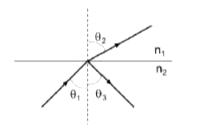When a ray of monochromatic light is incident obliquely on the interface of two media,
all the light is reflected back into same medium only.
all the light is transmited (refrected) into other medium.
only partially reflected back into the same medium.
Part of light is reflected back into the same medium.
The correct Answer is:D
Step by step video, text & image solution for When a ray of monochromatic light is incident obliquely on the interface of two media, by Physics experts to help you in doubts & scoring excellent marks in Class 11 exams.
Updated on:21/07/2023Topper's Solved these Questions
- REFRACTION OF LIGHT BOOK - TARGET PUBLICATIONCHAPTER - REFRACTION OF LIGHT EXERCISE - CRITICAL THINKING
53 Videos
- REFRACTION OF LIGHT BOOK - TARGET PUBLICATIONCHAPTER - REFRACTION OF LIGHT EXERCISE - COMPETITIVE THINKING
80 Videos
- RAY OPTICSBOOK - TARGET PUBLICATIONCHAPTER - RAY OPTICSEXERCISE - EVALUATION TEST
14 Videos
- SCALARS AND VECTORSBOOK - TARGET PUBLICATIONCHAPTER - SCALARS AND VECTORSEXERCISE - Evaluation Test
19 Videos
Similar Questions
What happens when a ray of light is incident normal to the interface between two media? Draw the corresponding neat and labelled diagram.
View SolutionA monochromatic beam of light is incident at the interface of two materials of refractive index n1 and n2 as shown . If n1>n2 and θC is the critical angle then which of the following statements is NOT true ?

View Solution
Knowledge Check
A ray of monochromatic light is incident on the plane surface of separation between two media x and y with angle of incidence i in the medium x and angle of refraction r in the medium y. The graph shows the relation between sin i and sin r.
 AThe speed of light in the medium y is √3 times than in mediun xBThe speed of light in the medium y is 1√3 times than in medium xCThe total internal reflection can take place when the incidence is in xDThe total internal reflection can take place when the incidence is in y
AThe speed of light in the medium y is √3 times than in mediun xBThe speed of light in the medium y is 1√3 times than in medium xCThe total internal reflection can take place when the incidence is in xDThe total internal reflection can take place when the incidence is in yA ray of monochromatic light is incident on the refracting face of a prism (angle 75∘0 . It passes through the prism and is incident on the other face at the critical angle. If the refractive index of the prism is √2 , then the angle of incidence on the first of the prism is
A15∘B30∘C45∘D60∘A monochromatic beam of light is incident at the interface of two materials of refractive index n1 and n2 as shown . If n1>n2 and θC is the critical angle then which of the following statements is NOT true ?
 Aθ1=θ3 for all value of θ1Bcosθ2 is imagimary for θ1>θcCcosθ2=0 for θ1=θcDcosθ3 is imaginary for θ1=θc
Aθ1=θ3 for all value of θ1Bcosθ2 is imagimary for θ1>θcCcosθ2=0 for θ1=θcDcosθ3 is imaginary for θ1=θc
Explain the following giving reasons:
(a) When monochromatic light is incident on a surface separating two media, the reflected and refracted light both have the same frequency as the incident frequency. Explain why.
(b) When light travels from a rarer to a denser medium, the speed decreases. does the reduction in speed imply a reduction in the energy carried bythe light wave ?
(c) In the wave picture of light, intensity of light is determined by the square of the amplitude of the wave, what determines the intensity of light in the photon pisture of light ?
View SolutionWhen monochromatic light is incident on a surface separating two media, the reflected and refracted light both have the same frequecy as the incident frequecy. Explain why ?
View SolutionWhen a ray of light is incident normally on a surface, then
View SolutionAssertion : When monochromatic light is incident on a surface separting two media, the reflected and refracted light both have the same frequency as the incident frequency.
Reason: The frequency of monochromatic light depends on media.
View SolutionA: When monochromatic light is incident on a surface separating two media, the reflected and refracted light both have the same frequency as the incident frequency.
R: At any interface between the two media , the electric (and magnetic) fields must satisfy certain boundary conditions for all times and frequency determines the time dependence of fields.
View Solution
